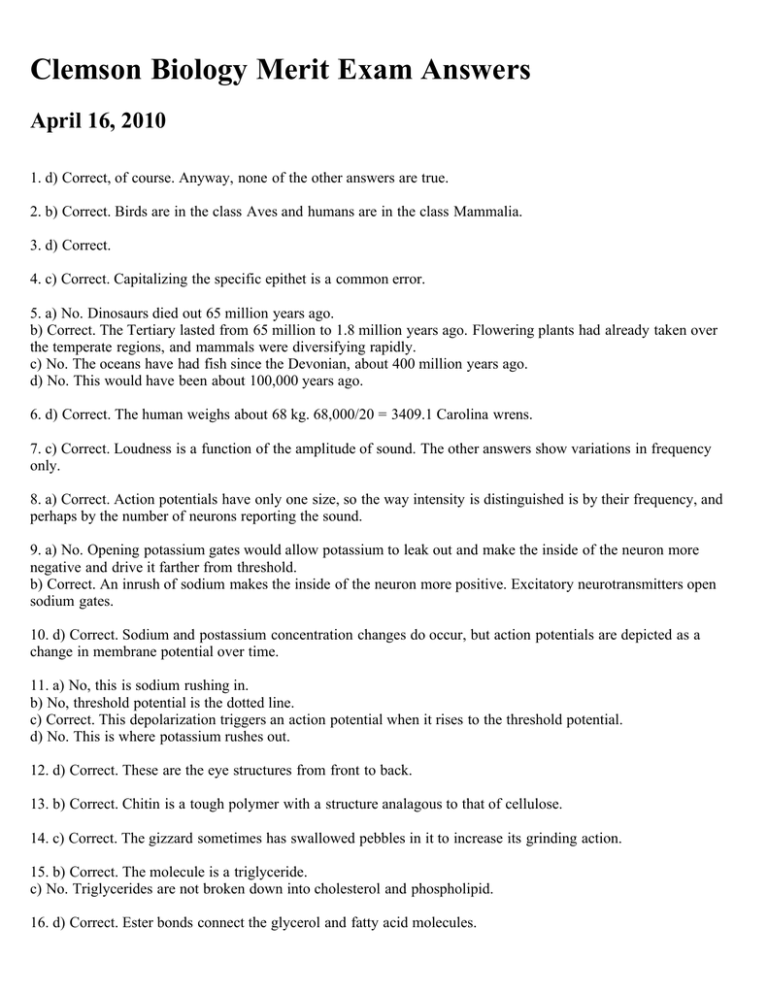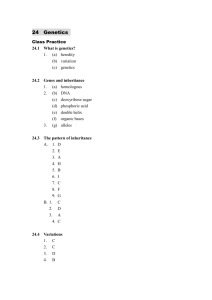2010 answer key
advertisement

Clemson Biology Merit Exam Answers April 16, 2010 1. d) Correct, of course. Anyway, none of the other answers are true. 2. b) Correct. Birds are in the class Aves and humans are in the class Mammalia. 3. d) Correct. 4. c) Correct. Capitalizing the specific epithet is a common error. 5. a) No. Dinosaurs died out 65 million years ago. b) Correct. The Tertiary lasted from 65 million to 1.8 million years ago. Flowering plants had already taken over the temperate regions, and mammals were diversifying rapidly. c) No. The oceans have had fish since the Devonian, about 400 million years ago. d) No. This would have been about 100,000 years ago. 6. d) Correct. The human weighs about 68 kg. 68,000/20 = 3409.1 Carolina wrens. 7. c) Correct. Loudness is a function of the amplitude of sound. The other answers show variations in frequency only. 8. a) Correct. Action potentials have only one size, so the way intensity is distinguished is by their frequency, and perhaps by the number of neurons reporting the sound. 9. a) No. Opening potassium gates would allow potassium to leak out and make the inside of the neuron more negative and drive it farther from threshold. b) Correct. An inrush of sodium makes the inside of the neuron more positive. Excitatory neurotransmitters open sodium gates. 10. d) Correct. Sodium and postassium concentration changes do occur, but action potentials are depicted as a change in membrane potential over time. 11. a) No, this is sodium rushing in. b) No, threshold potential is the dotted line. c) Correct. This depolarization triggers an action potential when it rises to the threshold potential. d) No. This is where potassium rushes out. 12. d) Correct. These are the eye structures from front to back. 13. b) Correct. Chitin is a tough polymer with a structure analagous to that of cellulose. 14. c) Correct. The gizzard sometimes has swallowed pebbles in it to increase its grinding action. 15. b) Correct. The molecule is a triglyceride. c) No. Triglycerides are not broken down into cholesterol and phospholipid. 16. d) Correct. Ester bonds connect the glycerol and fatty acid molecules. 17. d) Correct. Imagine that the protein has an alpha helix secondary structure and the analogy will be perfect. 18. a) Correct. DNA codes for the order of amino acids in the primary structure, and all other protein properties flow from that. 19. a) No, the mRNA would be CGC. b) No, the non-template DNA would be CGC. c) Correct. tRNA anticodons would be complementary to the mRNA codons, and would be GCG. 20. a) Correct. This is the "brush border" of intestinal cells. 21. d) Correct. If a cell doubles in diameter, it multiplies its surface area by 4 and its volume by 8. This means that its S/V ratio drops by a factor of 2. If it increases in diameter by a factor of 4, its S/V ratio drops by a factor of 4. Curve 5 is the only curve that comes close to this exponential relationship, even though it's not perfect due to the limitations of my drawing software. Answers a and b are out of the question because they show S/V ratio increasing as the cell gets larger. 22. a or c) No. Both of these would lead to a small S/V ratio. b) Correct. The cell with a large S/V ratio has a large ratio of supply to demand. 23. d) Correct. The central vacuole occupies the center of the cell with inert fluid that does not demand oxygen or produce wastes. It also pushes the cytoplasm out to the cell wall where it can easily exchange with the environment. 24. a) Correct. First, this is the only answer that shows the cell looking bigger at higher magnification. Also, if you increase magnification from 40x to 100x (2.5 times), the cell will appear 2.5 times bigger, which will mean that it occupies 2.5 x 20 % = 50% of the FOV. 25. b) Correct. Blood returning from the body goes to the right atrium. 26. a) Correct. From the right atrium, the blood will go to right ventricle and then the lungs. 27. c) Correct. A resting chicken has a heart rate of 275 bpm and a blood temperature of 107° F. An exercising chickadee has a heart rate of 1280 bpm! As for blood pressure, the principle is that the smaller the animal is, the shorter the distance the blood has to go, so smaller animals have lower blood pressure. The main factor appears to be the height of the head over the heart. Researchers speculate that long-necked dinosaurs may have needed systolic pressures of 1100 mm Hg to get the blood up to the head. 28. d) Correct. Oxygen serves as a molecule that accepts electrons from food molecules and releases the energy of the electrons in the process. It's something like a valley into which rocks can be rolled to release their energy. However, this does not mean that the valley has energy itself. 29. a) No. It might be trying to get rid of CO2, but that would bring its blood pH up. b) Correct. If its circulatory system were in better shape, it could keep the bird's muscles aerobic through the exercise, and no lactic acid would accumulate. The parakeet must breathe hard after the exercise stops in order to oxidize this lactic acid. c) No. Oxygen has nothing to do with breaking down glycogen. d) No. Lack of oxygen does not disable ATP synthase. 30. a) Correct. A higher concentration of oxygen in the lungs maintains a steeper diffusion gradient into the blood. 31. c) Correct. Cork covers the outside of the plant, but the strength of the branch comes from secondary xylem. 32. d) Correct. Hard one. Note that the light curve is two legs of a triangle, meaning that the average is half the peak height. This means that the average light experienced by the tallest trees during the daylight hours is 50% of maximum, and this is enough to give a 100% photosynthetic rate. The peak light expeienced by the bushes is about 20%, meaning that the average is about 10%. 10% of maximum light is still enough to give a photosynthetic rate that is 60% of the maximum. None of the other answers come close. 33. a) Correct. Fruits are ripened ovary walls. c) No. Endosperm is inside the seed. 34. a) No. "Viparous" is a made-up word. b) Correct. This means they lay eggs that hatch outside the body. c) No. This means they bear live young nourished with a placenta and do not have an egg that hatches internally. d) No. This means they have eggs, but the eggs hatch inside the body and the young are born live (as in some sharks and snakes). 35. a) Correct. One set of genes implies one copy of each allele. b) and c). No. An egg about to be fertilized would have 15 monads and 15 molecules of DNA. 36. d) Correct. By telophase I the cell had 15 chromosmes. They were dyads, but this is the first time it had 15 chromosomes. Looking at it another way, the daughter cells of meiosis I are the first cells that are haploid. 37. a) No. There is no evidence of sex linkage. b) No. When long is mated with short, the offspring are short. c) Correct. The supercilium length appears to be controlled at one autosomal locus, and short is dominant. The short offspring in the third line of the table will be heterozygous, as is proven by the fourth line of the table. When these heterozygous short offspring are mated with other wrens like themselves, they will produce 3/4 short and 1/4 long offspring. d) No. The offspring will not be all short. 38. a) No. There is no indication that "short" wrens reproduce less. b) Correct. Hardy-Weinberg equilibrium demands random mating. 39. a) Correct. The second fragment from the left in the "long" lane has been cut approximately in half and appears as two new fragments in the "short" lane. b) No. There are more fragments in the short lane. c) and d) No, restriction analysis cannnot tell which genes are active. 40. d) Correct. Sediba is an African word meaning "wellspring." Some anthropologists say that this species is the most likely candidate for origin of Homo habilis.






